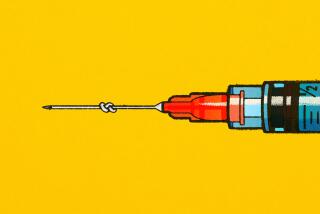Injecting a look of good health
- Share via
Doctors have known for decades that silicone injections can permanently plump fine lines, banish wrinkles and restore facial fullness that aging has taken away. But the popularity of these cosmetic treatments has tended to ebb and flow through the years.
Now some dermatologists and plastic surgeons are reporting an increased interest in injectable silicone, especially among HIV-infected men seeking to erase the gaunt, hollow appearance that has come to be called “the face of AIDS.” It isn’t known whether the loss of facial fat, called lipoatrophy, results from HIV infection or the medications used to keep it at bay. Patients say that these distinct facial changes -- sunken cheeks and bony temples -- can subject them to painful stigma even as many are living longer, relatively healthy lives.
The doctors who treat HIV-infected men and women and other patients seeking a permanent filler for wrinkles, lines or scars, say that today’s silicone is purer, the techniques safer and results better than in the past. And demand for cosmetic silicone treatment may grow if a new liquid silicone developed for the face is approved by federal regulators.
There are critics of the procedure, however. They caution that although silicone injections often bring impressive results initially, some people develop unsightly bumps and lumps years later. Las Vegas was awash in silicone in the 1950s and 1960s, long before silicone gel breast implants -- introduced in 1962 -- became popular. Many performers in Las Vegas and Hollywood had silicone injections in their faces and bodies, and some developed disfiguring aftereffects years later.
Despite risks that may still exist, many HIV-infected people are seeking a way to improve an appearance that makes them look older and sicker than they actually are.
Peter Anderson, a 54-year-old nurse practitioner in Los Angeles, has been living with HIV for at least 17 years. His virus is well-controlled by medications, and he’s never had any AIDS-related illnesses.
About five years ago, though, he began noticing the significant loss of fat in his arms, legs and face. Anderson no longer wears short pants and made peace with veins and muscles revealed when fat melted from his arms. But he couldn’t hide the pronounced hollows that he thought made his face look much older.
“If I’m walking down the street, I don’t want somebody to look at me and say, ‘He’s HIV-infected,’ ” said Anderson, who underwent six months of silicone treatments. “I am more than willing to tell anybody my HIV status ... but I don’t want them to make that assumption.”
Anderson accepts the unknowns of silicone just as he accepts the risks of his HIV medications. He discusses these risks, as well as benefits, in his job at Pacific Oaks Medical Group in Beverly Hills, a large, private AIDS practice, where he coordinates silicone treatments for several dozen patients.
Some doctors, though, say the risks may be too great, noting that experts aren’t sure exactly how silicone reacts in the body over decades.
Dr. Marvin Rapaport, a Beverly Hills dermatologist who has seen scores of silicone-related complications, calls liquid silicone “a time bomb” because problems can develop even 25 years after treatment.
In 1996, Rapaport published a report about 54 problem cases. The silicone produced lumps, bumps, infection and inflammation. It settled in the jowls. Attempts to remove silicone surgically often left patients worse off in appearance. He’s since seen 15 additional cases.
Rapaport believes some doctors are too cavalier about a procedure that nearly always works very well -- at least in the short term. The problem is, “the true incidence of side effects is unknown,” he said.
Not surprisingly, doctors who routinely perform silicone treatments, including the pioneer of facial silicone injections, Dr. Norman Orentreich, and his son Dr. David S. Orentreich, say such concerns are unfounded.
“People who use good technique, good judgment and good material are going to get good results,” said David Orentreich, a Manhattan dermatologist who trains other doctors in silicone use. Some doctors estimate that adverse outcomes occur in about 1% of patients who undergo silicone treatments, though there have been no definitive studies of the subject. Orentreich said complications can occur when doctors use silicone that hasn’t been sterilized and filtered to remove heavy metals and other impurities that can easily contaminate it during manufacturing. He said they also occur when doctors inject excessive quantities at once, or when they inject the silicone improperly.
The Orentreichs favor the serial puncture technique, in which silicone micro-droplets (each about the size of a grain of couscous) are injected into the skin once a month for several months. This technique gives the body time to wall off the silicone with a shell of collagen, said David Orentreich. Repeated treatments rebuild what has been lost to age or disease. Orentreich estimates that he has injected thousands of patients for cosmetic reasons, and about 50 men with HIV-related facial wasting.
Dr. Derek H. Jones, a Los Angeles dermatologist, estimates that he’s treated more than 200 men and three women with HIV-related lipoatrophy in the last year and a half. Six to 10 treatments are typically required at about $700 each, which can bring the total bill to as much as $7,000. Most health insurance plans do not cover the injections.
Jones began offering silicone after seeing HIV patients spend thousands of dollars on collagen injections that had to be repeated every few months, or get silicone shots from unlicensed practitioners in the U.S. or Mexico. He contends that some people may put themselves at “substantial risk” by going to Mexico for treatment that may be ineffective.
It will soon be up to the FDA to decide whether injectable silicone is indeed safe and effective.
Richard-James Inc., a medical implant developer in Peabody, Mass., received FDA permission in 2001 to test its highly purified Silskin silicone for cosmetic use and treatment of facial wasting.
Silicone injections have a checkered history. Although Dow Corning, which made silicone gel breast implants, manufactured the liquid silicone widely used since the 1960s, liquid silicone has never been approved for any facial or cosmetic purpose. Moreover, liquid silicone was illegal outside clinical studies until a few years ago, said Harold Pellerite of the FDA’s Center for Devices and Radiological Health.
In the early 1990s, the FDA began going after doctors who injected silicone illegally, including the Orentreichs. The investigations culminated in those doctors stopping the practice.
Then, in 1996, a change in federal law allowed doctors to use any legally marketed drug or device for any purpose they deemed necessary. When the FDA approved Richard-James’ Silikon 1000 for the treatment of complicated retinal detachments in September 1997, doctors finally had access to an approved injectable silicone product. That reopened the door for silicone as a facial filler. Richard-James sold Silikon 1000 to Alcon Laboratories in 1998 and then began focusing on bringing Silskin to the market specifically for use in the face.






